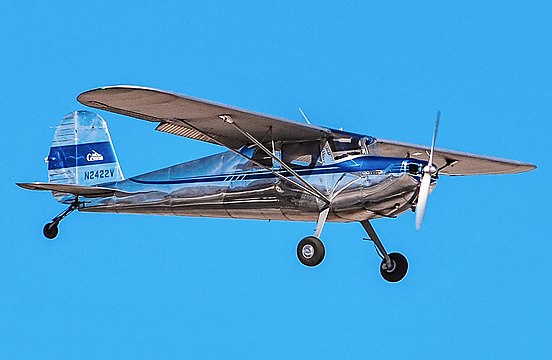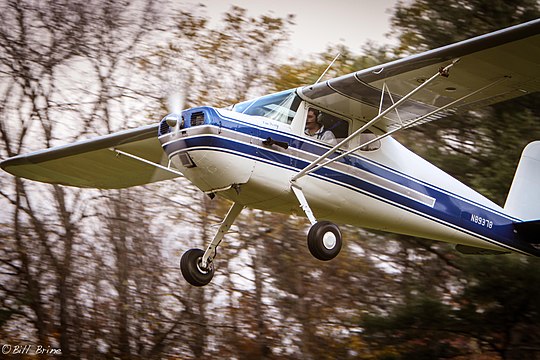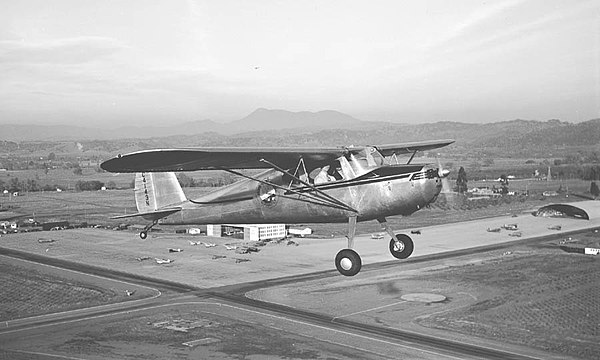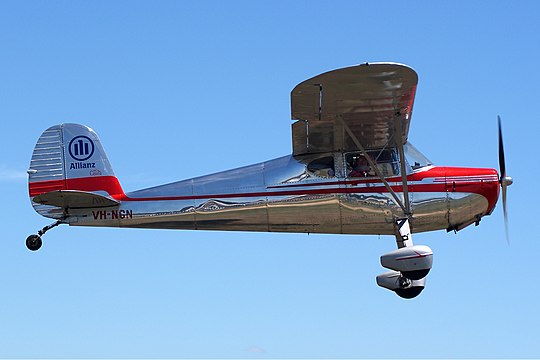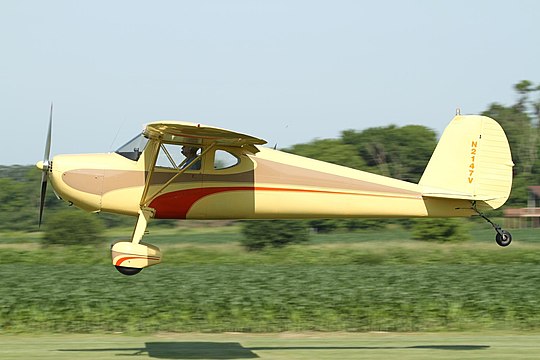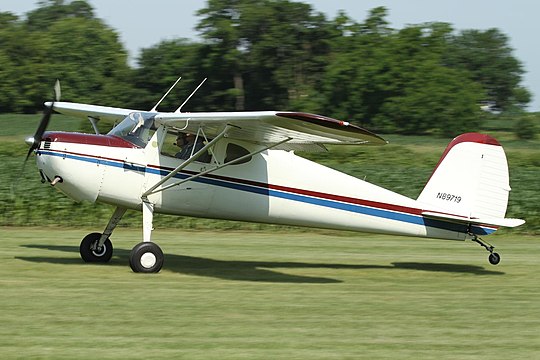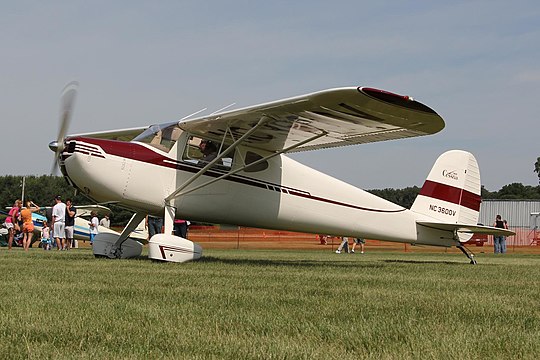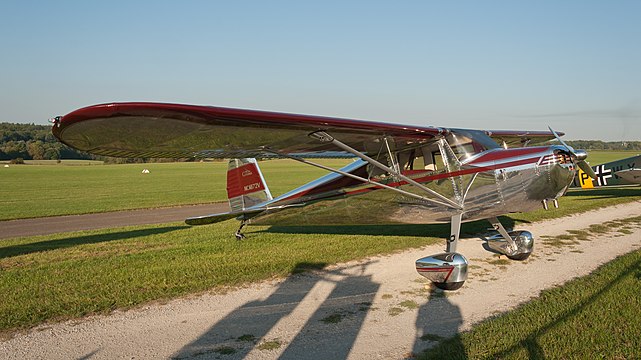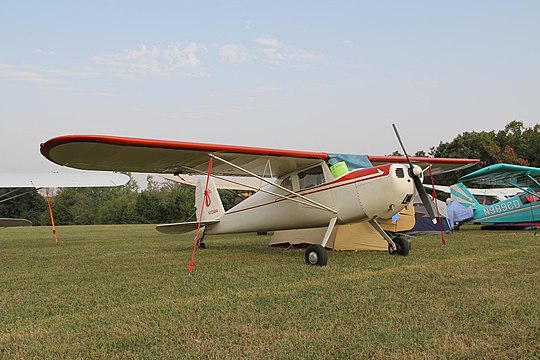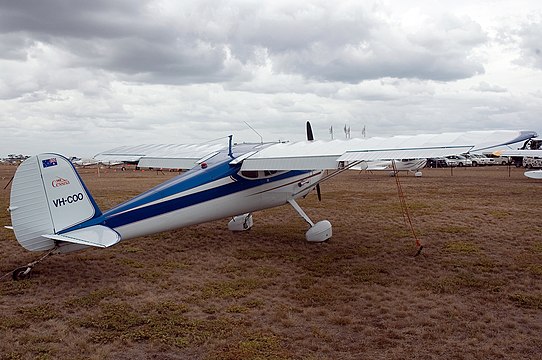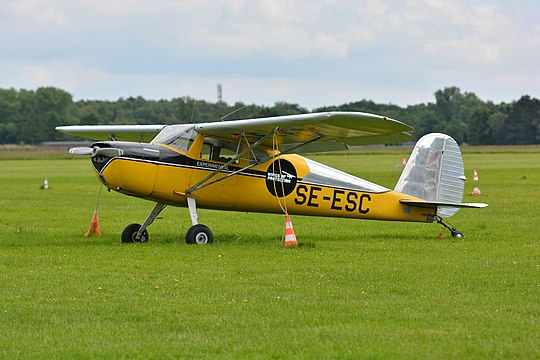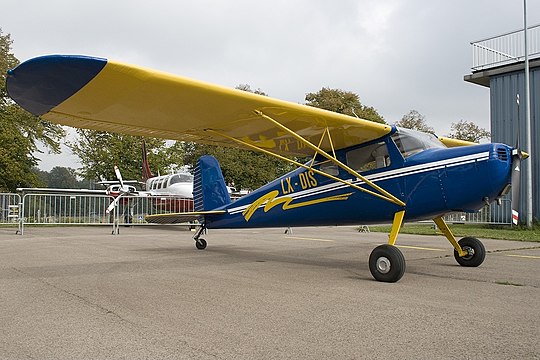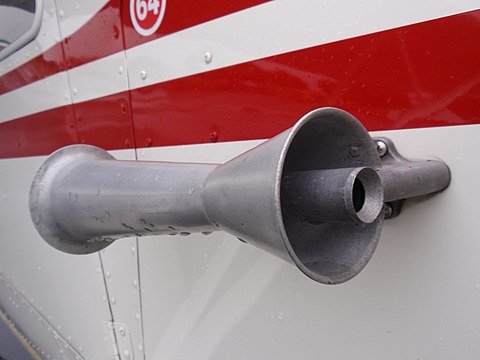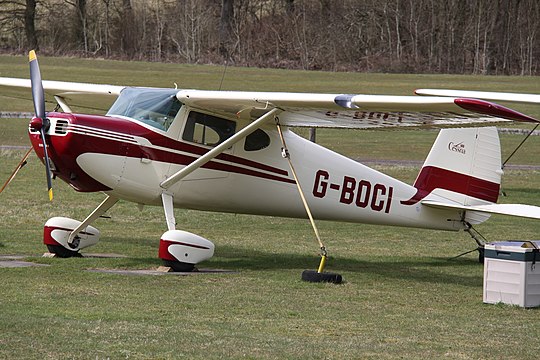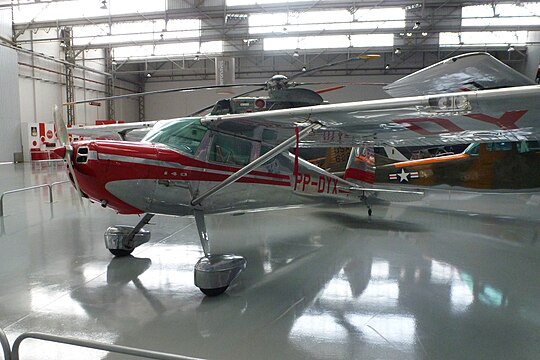Cessna 140
The Cessna 140 is a single-engined light aircraft with a high-mounted wing, tailwheel landing gear, and two seats placed side by side, produced by Cessna from 1946 through 1951. It is the more full-featured counterpart to the lower-cost Cessna 120.
The 140 was produced in two forms: the original 140 (with no suffix letter), built from 1946 through 1948, and the updated 140A, built from 1949 through 1951. The 140A differs from both the original 140 and the 120 in the shape of its wing and the form of the wing's support struts. (The 120 had no updated version; its production ended when the 140A was introduced.)
Original Cessna 140 (1946–1948)[edit]
The wing on the original 140 and the 120 is fabric-covered, has round ends, and is supported on each side by a V-shaped pair of lift struts that are reinforced by smaller jury struts. The original 140 is almost indistinguishable from the 120, except that the 140 has flaps while the 120 does not. A 140's flaps are most obvious when they are deployed, but otherwise they can sometimes be made out as narrow corrugated bands on the inboard trailing edges of the wing; on the 120 this area is smooth. The 140 always has rear side windows, but many 120s also have these.
The following group of photos all show original 140s produced from 1946 through 1948; some have their main wheels covered by streamlined "wheel pants".
-
N2422V
-
N89378
-
NC4143N over Santa Rosa Airport in 1947
-
VH-NCN
-
N2147V (more photos)
-
N2147V
-
N89719
-
N2084V (more photos)
-
N3600V (more photos)
-
N3600V
-
N2147V
-
NC89109 (more photos)
-
NC89109
-
NC1872V (more photos)
-
NC1872V
-
N72484
-
LN-TSC at Tønsberg Airport, Norway in 1957
-
N89605
-
N1044G
-
VH-COO (more photos)
-
SE-ESC
-
LV-NYZ
-
N90068
The 140 could also be equipped with floats or skis, as on the original 140 floatplane NC76415 shown here:
Some original 140s (as well as 120s) from the 1946 and 1947 model years have been equipped with special "landing gear extenders" that offset the main wheels several inches forward from the gear legs in order to reduce the chance of the airplane tipping onto its nose if the pilot brakes too hard. (On the 1948 models, Cessna slanted the main landing gear legs further forward to get the same effect, but the difference between the new and old gear legs is usually difficult to see.)
-
LX-DIS, a 1947 model 140 with landing gear extenders (more photos)
-
LX-DIS
-
Closeup of a 140's landing gear extender
The following photo shows the cabin and instrument panel of NC89334, a 1946 Cessna 140. (More NC89334 photos).
This next photo shows another 140's venturi tube, an external device sometimes equipped on older light aircraft. The tube generates a partial vacuum from airflow past the aircraft, and this vacuum drives the gyroscopes of some cockpit instruments. Such venturis can also be seen in some of the preceding photos.
Brazil's TAM Museum has a diorama built around the remains of a particular Cessna 140, PP-DOO, the airplane of Milton Verdi [article in Portuguese], who in 1960 during a flight from Corumbá, Brazil, to Santa Cruz, Bolivia, was forced to land in the Bolivian jungle after going off course and running out of fuel. Verdi's companion died within a week, but Verdi managed to live on for 70 days, writing of his ordeal on magazines and maps that happened to be in the aircraft, before he finally succumbed to starvation. The wreck wasn't found until about one and a half months later, whereupon the victims' remains were brought back. The aircraft itself was only recovered in the year 2000.
Cessna 140A (1949–1951)[edit]
In 1949 Cessna replaced the original 140 and 120 with the improved 140A model. This version had new, all-metal wings whose outer parts were mildly tapered, with squared-off tips. The wings were now supported by single streamlined struts rather than the original 140's V-struts. By this time the market had become saturated, so a relatively small number of 140As were built before production ended in 1951. As a result, the 140A is much less common than the original 140.
-
N1155D (photo from 1952)
-
G-BOCI
-
An unidentified 140A
-
N1145D at the Pima Air & Space Museum (more photos)
-
PP-DYX at Brazil's TAM Museum (more photos)
-
N140NT
The following photos show PT-ADV, a unique Cessna 140A held by Brazil's TAM Museum that was flown by Brazilian woman aviator Ada Rogato in 1951 on a goodwill tour through South, Central, and North America, covering a distance of 51,064 miles over a period of six months. This aircraft is covered in handwritten commemorative messages from the tour. (More PT-ADV photos.)

